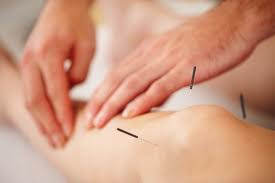 There
are many ways to build lean muscle that will make you look toned and
athletic. The key is to keep up with whichever method fits you best.
Fitness is not something that happens in x-amount of days. Instead,
fitness is a lifestyle that is lived through diet, exercise, mindfulness
and activity.
There
are many ways to build lean muscle that will make you look toned and
athletic. The key is to keep up with whichever method fits you best.
Fitness is not something that happens in x-amount of days. Instead,
fitness is a lifestyle that is lived through diet, exercise, mindfulness
and activity.“I’m too busy” is a common excuse when it comes to fitness. Investing an hour a day to fitness three to six times a week will give you more physical and mental health benefits than you can imagine. If you really break it down, what’s four hours a week to spend on exercise? When you look at devoting just four hours a week to exercise, it really doesn’t seem that intimidating.
For those with busy lives who don’t know where to start with their fitness, we offer a course that is specifically for those on the go. Not only does it help you to get fit with exercise, but it offers healthy diet options so you can start working toward that lean muscle.
Running
One of the best exercises for building lean muscle is running, and it’s one of the most affordable. All you need is proper shoes and clothing and you’re good to go. While it may not be the easiest at first, as long as you keep pushing and aiming for goals, running will become easy, rewarding and fun. And the more you keep with it, the more you will see your body change. That’s because running burns more calories than most types of cardio. If you have a gym membership, skip the bike, eliptical or stairstepper and hit the treadmill for 30 minutes. On average, you burn 100 calories per mile, which makes tracking calories easy. Running is an aerobic exercise, which is an exercise that burns fat, a key component in getting that lean muscle you want.Diet
Diet is just as important as exercise when it comes to losing fat and gaining muscle. Lean protein is the key to building lean muscle. Switch your diet from carb-heavy to lean-protein heavy and you will start seeing the changes in your body that you are aiming for. That’s not to say take carbohydrates out of your diet altogether, as they are important for energy. It is protein that helps rebuild muscle, so if it’s muscle that you’re looking to build, there should be more servings of protein in your diet than carbohydrates. A popular diet that many athletes and fitness enthusiasts use to look their best is the paleo diet. The diet (based on that of the Paleolithic humans) focuses on eating fish, grass-fed meats, eggs, vegetables, fruit, fungi, roots and nuts. With this course, you will learn more about the diet, as well as how it will help you get rid of fat and gain muscle.Weight Training
 Many people think that weight training is an exercise that will make
them bulk up. That is actually not true. You will not bulk up unless you
add supplements and extra calories in the form of protein in your diet.
As long as you keep with your balanced diet, you will see lean muscle
start to emerge. Strength training actually makes your body work harder
to maintain muscle over fat. This, in turn, helps to boost metabolism
and burn more fat and calories throughout the day. As we age, we lose
lean muscle and need to replace the muscle loss or else it will turn to
fat. Weightlifting is a great way to replace the muscle loss and prevent
fat. With this course, you will learn the importance of strength training, as well as the tools to gain muscle and lose fat.
Many people think that weight training is an exercise that will make
them bulk up. That is actually not true. You will not bulk up unless you
add supplements and extra calories in the form of protein in your diet.
As long as you keep with your balanced diet, you will see lean muscle
start to emerge. Strength training actually makes your body work harder
to maintain muscle over fat. This, in turn, helps to boost metabolism
and burn more fat and calories throughout the day. As we age, we lose
lean muscle and need to replace the muscle loss or else it will turn to
fat. Weightlifting is a great way to replace the muscle loss and prevent
fat. With this course, you will learn the importance of strength training, as well as the tools to gain muscle and lose fat.Yoga
Until you try yoga, you have no idea what an entire-body experience it really is. Yoga helps bring all your work — whether it’s running, biking, weightlifting, swimming — together. There are many health benefits you get from practicing yoga on a regular basis. Yoga is not only good for your body, but it reduces stress and depression, as well as helps you to sleep better. When it comes to body benefits, practicing yoga will strengthen muscles to help aches and pains, tone your body to get that lean muscle you’re looking for, improve flexibility, increase endurance (which will help with your cardio exercises), help your posture and more. A good yoga session leaves you feeling relaxed and replenished. If you’re interested in beginning yoga, don’t be intimidated. Yoga is a practice where nobody is perfect. You can always set goals for yourself and get better with your practice. This course we offer is yoga for everyone, which introduces yoga to beginners. In it, you learn sitting, standing and lying practices, as well as the importance of meditation. If you’ve got the hang of yoga and want to dive into the practice further, we also offer this course, which has more than 30 hours of techniques.Putting It All In Practice
Once you start a routine of diverse exercises and healthy eating, you will start seeing changes in your body over time. Losing fat and building lean muscle is not something that happens immediately, so we recommend keeping a journal of your progress and taking a photo of yourself at the beginning of each month to see how far you’ve come. It’s important to remember that in order to keep your lean muscle you’ve worked hard for, you need to create a healthy and positive lifestyle for yourself. It takes effort, but once you start seeing the changes in your body and in your mental health, you’ll want to keep going forward. The confidence that you get from maintaining a healthy and fit lifestyle is something that is worth all that hard work.Source







































